Navigation
Install the app
How to install the app on iOS
Follow along with the video below to see how to install our site as a web app on your home screen.
Note: This feature may not be available in some browsers.
More options
-
This forum is strictly intended to be used by members of the VS Battles wiki. Please only register if you have an autoconfirmed account there, as otherwise your registration will be rejected. If you have already registered once, do not do so again, and contact Antvasima if you encounter any problems.
For instructions regarding the exact procedure to sign up to this forum, please click here. -
We need Patreon donations for this forum to have all of its running costs financially secured.
Community members who help us out will receive badges that give them several different benefits, including the removal of all advertisements in this forum, but donations from non-members are also extremely appreciated.
Please click here for further information, or here to directly visit our Patreon donations page. -
Please click here for information about a large petition to help children in need.
You are using an out of date browser. It may not display this or other websites correctly.
You should upgrade or use an alternative browser.
You should upgrade or use an alternative browser.
Saint Seiya Discussion Thread (IV)
- Thread starter TheUnshakableOne
- Start date
-
- Tags
- saint seiya
- 6,489
- 1,704
- Thread starter
- #2,002
Yes and noare universes in saint seiya infinite?
- 9,266
- 3,411
elaborateYes and no
- 6,489
- 1,704
- Thread starter
- #2,004
It's both. Some universes are infinite while others are expanding spacetime continuum via inflation. The multiverse contains expanding ones.elaborate
- 9,266
- 3,411
It's both. Some universes are infinite while others are expanding spacetime continuum via inflation. The multiverse contains expanding ones.
I see, so only a select few universes are infinite?
- 6,489
- 1,704
- Thread starter
- #2,006
Yes. It's cosmic inflation theory. However, it's unclear of time is expanding with space. But time and space are born alongside each otherI see, so only a select few universes are infinite?
- 919
- 336
So, as promised, here are the scans I talked about:Literally the word used is "hoshi" which means celestial body and depending on the context it can mean planet, star or even just a meteorite or comet, so this does not indicate anything and as I explained in the scene we can only see what are small luminous objects that they orbit Earth's space, so there is nothing impressive about this and it's just not a good feat, because the author himself shows that they are not real stars in that scene.
From one of G Requiem's latest chapters. "Stars that rise from the ashes". I've already given you an explanation for the scan you use to say that the constellations are just 'space rocks', but even in the event that you were right, and the Okada meant for the constellations to be floating space boulders that is no longer the case.
- 1,034
- 230
Literally, during that scene the word they use is "hoshi (星)", which means celestial body and depending on the context this can describe a star, planet or even a meteorite or comet (this is something that can be seen in series like Dragon Ball where Planet Namek is called hoshi or Saintia Sho where the comet Repulse is known as The Star Goddess and they use the word hoshi to describe it, even when Saga destroys it that word is used, this is a normal confusion and many have made the assumption that they are destroying stars, when the meaning of the word is used to describe a celestial body and not just stars), so as I explained this does not mean that they are describing that it is a real star and we can simply see that they are small luminous celestial bodies around the space orbiting the Earth. The context of the series and what the author draws indicates that they are only small luminous bodies orbiting the Earth's space.So, as promised, here are the scans I talked about:
From one of G Requiem's latest chapters. "Stars that rise from the ashes". I've already given you an explanation for the scan you use to say that the constellations are just 'space rocks', but even in the event that you were right, and the Okada meant for the constellations to be floating space boulders that is no longer the case.
Last edited:
- 6,489
- 1,704
- Thread starter
- #2,009
Question, why is this debate important? why is it important if it even was constellations, or stars etc????
- 646
- 428
OK, so I'm looking at the scene and uh.....I'm not sure how you're getting that interpretation. We see the Whole Earth being attacked and in the background we see stars being destroyed. Then when Seiya's explaining his cosmos is running out we cut to the planet being attacked, but we again see stars in the background being destroyed. And then again, when he speaks of destroying the Constellastions, we see them being destroyed and the images aren't "small luminous celestial bodies around the Earth". When we see them, they're depicted as being stars in the distance from Earth, with lines to show what shape we're supposed to be seeing, which is consistent with both SS in the past and artistic depictions of them in real life art. We see a bunch of them being blown up, and we visually see the stars in the background as well being attacked, with the images in the foreground resembling previous depictions of Stars in Episode G and GA.
Hasty12345
Username Only- 5,357
- 4,199
This is just ridiculous. Everything in the sky is being affected, not just the constellations. There is not a single object aside from maybe the sun in the night sky. Obviously random space rocks were destroyed along with the constellations, we see this throughout the early chapters.
The rocks in the Stereops scan are not blue gaseous celestial bodies, they are rocks.
Please stop this absurdity.
The rocks in the Stereops scan are not blue gaseous celestial bodies, they are rocks.
Please stop this absurdity.
- 646
- 428
It's also pretty consistent as in Episode G: Assassin, we see stars in the background but nothing in the foreground to be the Constellations when they're fighting on the two planets, which to me indicates the Constellations are where they're supposed to be.
Hasty12345
Username Only- 5,357
- 4,199
Only Saint Seiya has to prove stars are stars on this website…
- 6,480
- 2,482
But the context is a constellation, so it would mean stars by defaultcontext this can describe a star, planet or even a meteorite or comet
- 6,480
- 2,482
I highly disagree, because although rocky bodies do appear to be destroyed during this segment, it’s also shown that many small and distant blue lights are being destroyed as well. This leaves us with the choice of considering either the rocks to be what make up the constellation, or we can consider the Glowing blue spheres to be the constellations referred to in the scan.the author draws indicates that they are only small luminous bodies orbiting the Earth's space.
The latter option makes more sense for two reasons. One, it’s previously shown to be that way in other scans, where constellations are blue lights with lines connecting them, showing their outline, and secondly, it’s simply common sense that Okada should know glowing stars make up constellations, and not say, comets do.
- 1,034
- 230
In neither of these two scenes do we see a single star being destroyed and we can only see that the Earth is being affected by the flames and only a part of the Earth was really being affected as we can see later, because these flames were slowly spreading across the Earth.OK, so I'm looking at the scene and uh.....I'm not sure how you're getting that interpretation. We see the Whole Earth being attacked and in the background we see stars being destroyed. Then when Seiya's explaining his cosmos is running out we cut to the planet being attacked, but we again see stars in the background being destroyed.
Here we can see how several of these constellations are close to the Earth and are represented as small luminous objects that are smaller than the Earth itself.And then again, when he speaks of destroying the Constellastions, we see them being destroyed and the images aren't "small luminous celestial bodies around the Earth". When we see them, they're depicted as being stars in the distance from Earth, with lines to show what shape we're supposed to be seeing, which is consistent with both SS in the past and artistic depictions of them in real life art. We see a bunch of them being blown up, and we visually see the stars in the background as well being attacked, with the images in the foreground resembling previous depictions of Stars in Episode G and GA.

Literally in this image, we can see that the rocky bodies that form the constellations that are destroyed are smaller than the Earth, so they are not stars in any way, they are simply celestial bodies with a quite small size.

The fact is that Okada does not in any way represent the destruction of a star in this scene, on the contrary he even clearly shows that in his vision of the story, the constellations are just small luminous objects that are orbiting around the Earth at that moment, as we can even see the Earth during the destruction of these objects. So this in no way qualifies as a feat, unless Okada actually shows that they are destroying real stars.
The context is what we see visually in the story and in this case they do not represent stars in any way.But the context is a constellation, so it would mean stars by default
In both scenes we can clearly see that the constellations for Okada are represented by small luminous objects around the Earth and they are never shown in any scene as real stars, even in the scene where we can see that these are destroyed they are again represented in this way. This is not about what the author knows, but what the author seeks to represent in that scene, because even if the author knows that it is a star, he simply does not seek to represent it in this way.I highly disagree, because although rocky bodies do appear to be destroyed during this segment, it’s also shown that many small and distant blue lights are being destroyed as well. This leaves us with the choice of considering either the rocks to be what make up the constellation, or we can consider the Glowing blue spheres to be the constellations referred to in the scan.
The latter option makes more sense for two reasons. One, it’s previously shown to be that way in other scans, where constellations are blue lights with lines connecting them, showing their outline, and secondly, it’s simply common sense that Okada should know glowing stars make up constellations, and not say, comets do.
Irrelevant, because the scene in question that you want to present as a feat represents the constellations in that way, so Okada simply makes one of his many changes in the drawing of his manga, something that is not strange coming from this author who has little consistency in these details. If you want to present this as a feat, it has to be a visual representation of it, something that does not happen during a scene where the visual representation shows something different.I pretty much agree with everything said above. G Assassin alone proves this nonsense idea wrong as we get not one, not two, not three, but multiple shots of the Earth's orbit with no big blue rocks orbiting around it.
Last edited:
- 646
- 428
So, first, for them being "small luminous and close to Earth" No. They're in the background, and we have zero way of telling where they are. Again, this isn't really supported by the text as you think it does.
- 6,480
- 2,482
Well if you interpret it like that, you would also support the earth floating in water then.Here we can see how several of these constellations are close to the Earth and are represented as small luminous objects that are smaller than the Earth itself.
This requires the assumption they are constellations.Literally in this image, we can see that the rocky bodies that form the constellations t
Let’s see what we know first. Firstly, the constellations are made of Blue glowing celestial objects. Correct? Secondly, we know that two different type of objects are being hit by red beams. One are dark spherical rocks, the other are very small OR very distant blue glowing celestial objects.
Therefore, we can assume that those are the same Blue glowing objects as what is shown to make up the
constellations in previous depictions.
We have no reason to consider the rocks to be the constellations over the glowing objects because they look considerably more dissimilar to the constellations, then the glowing objects behind them.
Following this train of logic, I would conclude that these glowing objects are indeed stars, because Stars are conventionally what make up constellations, Glow, and stars are very common in space, which matches what we see. Many many multitudes of Glowing objects.
my point is that It wouldn’t make sense for the dark objects to be constellations because the constellations are depicted as collections of bright objects.
- 919
- 336
If you genuinely don't understand why Okada would choose to highlight the constellations by making them bigger in the scan thereby making them stand out amidst countless other stars then I don't know what to tell you. Do you also believe there's an actual winged sky horse whenever we see a Saint Seiya mangaka draw a Pegasus over the Pegasus Constellation?want to present as a feat represents the constellations in that way, so Okada simply makes one of his many changes in the drawing of his manga, something that is not strange coming from this author who has little consistency in these details. If you want to present this as a feat, it has to be a visual representation of it, something that does not happen during a scene where the visual representation shows something different.
- 919
- 336
To add onto that, Stek has already proven that the constellations are the blue dots seen in the scans you posted. And we also know from scans in GA that these 'small luminous objects' are nowhere to be found in Earth's atmosphere. Now obviously the constellations must still exist, as we know from what GR what happens when they are destroyed, leading us to the conclusion that they are part of the stars of the night sky.
- 1,034
- 230
It is only a description of Pontos attacking the constellations as indicated by Shion himself, but we can see the representation of the constellations at that moment as small spheres of light.Well if you interpret it like that, you would also support the earth floating in water then.
They look exactly the same and are part of the same spheres that form these constellations even they are connected by lines, they are simply the constellations we see in that scene that are visually destroyed as Steropes is describing, and the only reason they look dark is because they were hit by the flames and destroyed as seen visually, that's why they have lost their brightness and are disappearing.Well if you interpret it like that, you would also support the earth floating in water then.
This requires the assumption they are constellations.
Let’s see what we know first. Firstly, the constellations are made of Blue glowing celestial objects. Correct? Secondly, we know that two different type of objects are being hit by red beams. One are dark spherical rocks, the other are very small OR very distant blue glowing celestial objects.
Therefore, we can assume that those are the same Blue glowing objects as what is shown to make up the
constellations in previous depictions.
We have no reason to consider the rocks to be the constellations over the glowing objects because they look considerably more dissimilar to the constellations, then the glowing objects behind them.
Following this train of logic, I would conclude that these glowing objects are indeed stars, because Stars are conventionally what make up constellations, Glow, and stars are very common in space, which matches what we see. Many many multitudes of Glowing objects.
my point is that It wouldn’t make sense for the dark objects to be constellations because the constellations are depicted as collections of bright objects.
The scene is simple: the character is describing the destruction of the constellations and the visual scene shows us the destruction of these small bright objects that orbit the Earth and form the constellations.
Visually as we can see in that scene, the flames only covered the Earth and the space around it, we never see a scene where they spread even to another planet or outside the solar system, it is simply affecting the Earth and its sky.
We rely on the representation that the author gives about this in his universe, where nowhere does he represent this as stars, something that is really easy to draw, so Okada simply believes that constellations are small spheres found in the Earth's sky and this is what he represents visually for his universe.If you genuinely don't understand why Okada would choose to highlight the constellations by making them bigger in the scan thereby making them stand out amidst countless other stars then I don't know what to tell you. Do you also believe there's an actual winged sky horse whenever we see a Saint Seiya mangaka draw a Pegasus over the Pegasus Constellation?
To add onto that, Stek has already proven that the constellations are the blue dots seen in the scans you posted. And we also know from scans in GA that these 'small luminous objects' are nowhere to be found in Earth's atmosphere. Now obviously the constellations must still exist, as we know from what GR what happens when they are destroyed, leading us to the conclusion that they are part of the stars of the night sky.
Literally, it is because they are being destroyed and are losing their brightness, it is simply the representation of the destruction of these objects in that scene, which as we know are not even real stars. Simply the visual representation of that scene shows us that the constellations were never formed by stars and are just small spheres in the sky of the Earth, that is why even the constellation of the Phoenix returns later, confirming that this has nothing to do with what we know in reality and simply is the vision that this author has about the constellations in this fictional world.
As I explained to you, visually there is no scene in which we see the destruction of a star or even a planet, and we only see some flames spreading to the Earth and its sky, something that as I said does not qualify in any way as a feat, because the visual representation shows something completely different.
Last edited:
Hasty12345
Username Only- 5,357
- 4,199
It’s very clear from GA and actually reading GR as opposed to using arguments you’ve found on comicvine and not reading this manga that the constellations are stars.
- 1,034
- 230
A new Saint Seiya spin-off was announced.
聖闘士星矢 海皇再起 RERISE OF POSEIDON (Saint Seiya: Rerise of Poseidon)
Mangaka: 須田綱鑑 (Tsunagami Suda/Tsunayoshi Suda)


A new "Saint Seiya" begins, featuring the Sea Emperor Poseidon and the Sea Shogun (Generals)!.
Short Synopsis:
The Saints are gone in their battle against Hades, and the Sea Emperor Poseidon awakens to the danger of a new enemy approaching the Earth!
The new spin-off will begin with its first chapter in Champion RED magazine published in September.
This means that the September magazine will have three chapters of the Saint Seiya series, the 18th chapter of Dark Wing (which will have the cover of the magazine this month), a special chapter of Episode.G (published for the 20th anniversary of the series) and the chapter of Rerise of Poseidon. And it will also include the second part of Time Odyssey, which is published as a small comic included with the acquisition of the magazine.
Saintia Sho Memories will move to Manga Cross digital magazine (the magazine where Episode.G Requiem is published) in the fall, so it is unknown if the September magazine will include a chapter of this manga or this month's chapter will be the last one published in Champion RED and after this month it will move to Manga Cross magazine.
Some illustrations of the mangakas of Saint Seiya to celebrate the 20th anniversary of the Champion RED.
聖闘士星矢 海皇再起 RERISE OF POSEIDON (Saint Seiya: Rerise of Poseidon)
Mangaka: 須田綱鑑 (Tsunagami Suda/Tsunayoshi Suda)


A new "Saint Seiya" begins, featuring the Sea Emperor Poseidon and the Sea Shogun (Generals)!.
Short Synopsis:
The Saints are gone in their battle against Hades, and the Sea Emperor Poseidon awakens to the danger of a new enemy approaching the Earth!
The new spin-off will begin with its first chapter in Champion RED magazine published in September.
This means that the September magazine will have three chapters of the Saint Seiya series, the 18th chapter of Dark Wing (which will have the cover of the magazine this month), a special chapter of Episode.G (published for the 20th anniversary of the series) and the chapter of Rerise of Poseidon. And it will also include the second part of Time Odyssey, which is published as a small comic included with the acquisition of the magazine.
Saintia Sho Memories will move to Manga Cross digital magazine (the magazine where Episode.G Requiem is published) in the fall, so it is unknown if the September magazine will include a chapter of this manga or this month's chapter will be the last one published in Champion RED and after this month it will move to Manga Cross magazine.
Some illustrations of the mangakas of Saint Seiya to celebrate the 20th anniversary of the Champion RED.
Masami Kurumada:

Teshirogi Shiori:

Megumu Okada:

Chimaki Kuori:

Yun Koga (wow, this author resurrected for a new image):

Shinshu Ueda and Kenji Sato:

Tsunagami Suda/Tsunayoshi Suda:


Teshirogi Shiori:

Megumu Okada:

Chimaki Kuori:

Yun Koga (wow, this author resurrected for a new image):

Shinshu Ueda and Kenji Sato:

Tsunagami Suda/Tsunayoshi Suda:

Last edited:
- 6,489
- 1,704
- Thread starter
- #2,028
do you debate Saint Seiya in places like Reddit or Comicvine?A new Saint Seiya spin-off was announced.
聖闘士星矢 海皇再起 RERISE OF POSEIDON (Saint Seiya: Rerise of Poseidon)
Mangaka: 須田綱鑑 (Tsunagami Suda/Tsunayoshi Suda)


A new "Saint Seiya" begins, featuring the Sea Emperor Poseidon and the Sea Shogun (Generals)!.
Short Synopsis:
The Saints are gone in their battle against Hades, and the Sea Emperor Poseidon awakens to the danger of a new enemy approaching the Earth!
The new spin-off will begin with its first chapter in Champion RED magazine published in September.
This means that the September magazine will have three chapters of the Saint Seiya series, the 18th chapter of Dark Wing (which will have the cover of the magazine this month), a special chapter of Episode.G (published for the 20th anniversary of the series) and the chapter of Rerise of Poseidon. And it will also include the second part of Time Odyssey, which is published as a small comic included with the acquisition of the magazine.
Saintia Sho Memories will move to Manga Cross digital magazine (the magazine where Episode.G Requiem is published) in the fall, so it is unknown if the September magazine will include a chapter of this manga or this month's chapter will be the last one published in Champion RED and after this month it will move to Manga Cross magazine.
Some illustrations of the mangakas of Saint Seiya to celebrate the 20th anniversary of the Champion RED.
Masami Kurumada:

Teshirogi Shiori:

Megumu Okada:

Chimaki Kuori:

Yun Koga (wow, this author resurrected for a new image):

Shinshu Ueda and Kenji Sato:

Tsunagami Suda/Tsunayoshi Suda:

- 1,034
- 230
The Episode 6 of Knight of the Zodiac was pretty good, probably one of the best of the series so far.
Some details:
As for the rest of the Episode, it was a good adaptation of the end of Deathmask and Shiryu's fight, and the beginning of Aiolia and Seiya's fight.
In the previous chapter it was revealed that Daidalos in this version was Shion's student and Mu's training partner, a great detail. Also, it seems that Marin and June (that character with a great design that Kurumada has completely forgotten) will have more participation in this series and will investigate the mystery of the Star Hill, and Aldebaran and Mu accompanies them in this mission.
This second season is quite good, although it is still not the classic anime, it is better than Toei's last animated projects based on this franchise.
Some details:
- Aiolia is weaker than in the original manga and Shaka almost hit him with the Tenma Kofuku (he was saved by the Pope interrupting the fight), after dodging the Lightning Bolt with teleportation, so contrary to the original manga where Aiolia is an elite warrior and one of the strongest, in this series he is probably at the level of Gold Saints like Camus, Shura, Aphro and Deathmask, even his technique was as easy to dodge as Excalibur.
- If there is someone whose power seems more impressive in this series, even more than it already was in the original manga, it is the Pope (who everyone knows is Saga), he even has mental powers/telekinesis so powerful as to stop Aiolia's movements with ease and after this apply the Genrōmaōken. Something that in the original manga, Saga never stood out at this level, being the most powerful in this aspect, Shion, Mu, Shaka, Dohko and Deathmask. And I forgot to mention it in the previous chapters, but the Gemini Temple illusion is described by Shiryu as a spatial distortion, so in this series it is not a basic illusion that only affects the eyesight as in the original manga.
- Aphrodite says he doesn't know what the Pope is thinking, so perhaps in this version he is unaware of any plan to kill Athena and believes in the Prophecy.
- Shaka seems to admire the Pope a lot in this version, it will be interesting to see how he reacts to the truth of his identity.
As for the rest of the Episode, it was a good adaptation of the end of Deathmask and Shiryu's fight, and the beginning of Aiolia and Seiya's fight.
In the previous chapter it was revealed that Daidalos in this version was Shion's student and Mu's training partner, a great detail. Also, it seems that Marin and June (that character with a great design that Kurumada has completely forgotten) will have more participation in this series and will investigate the mystery of the Star Hill, and Aldebaran and Mu accompanies them in this mission.
This second season is quite good, although it is still not the classic anime, it is better than Toei's last animated projects based on this franchise.
With my work and my other projects I barely have time to comment on this forum.do you debate Saint Seiya in places like Reddit or Comicvine?
Last edited:
- 6,489
- 1,704
- Thread starter
- #2,030
I feel ya thereWith my work and my other projects I barely have time to comment on this forum.
- 1,034
- 230
Kurumada's blog published a preview of the new chapters of Next Dimension.
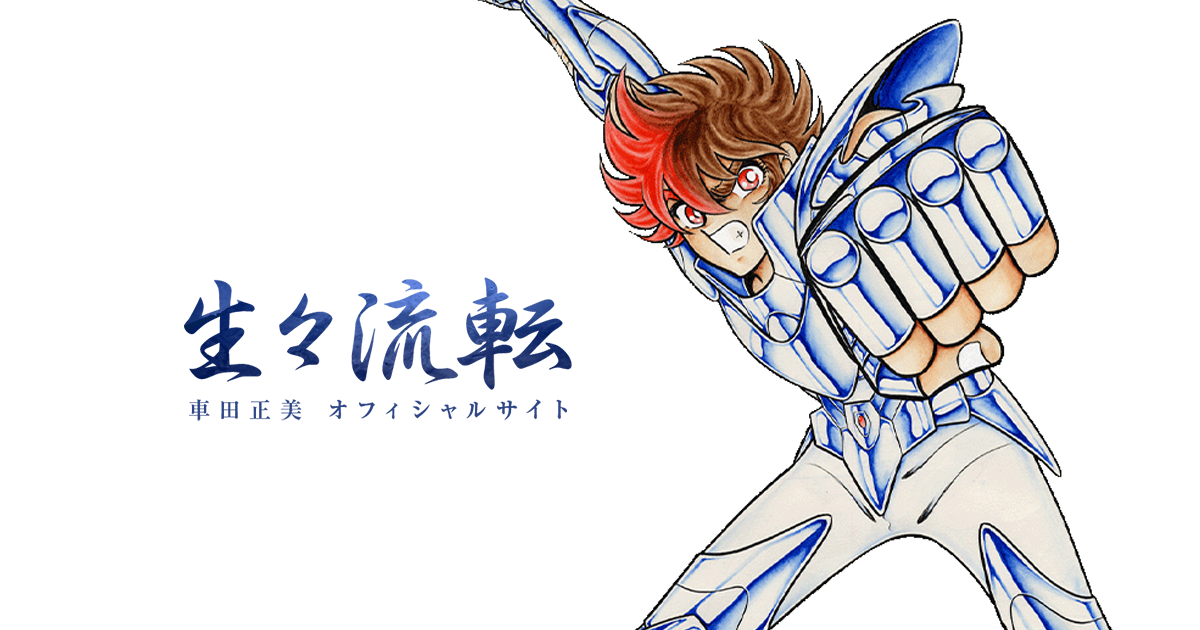
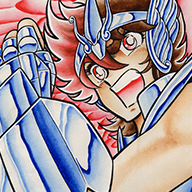 kurumadapro.com
kurumadapro.com
Production of the final series of "Seiya ND” is going well!
The story is finally reaching its climax!!

Although there is no date indicating when the new chapters will be published, this could indicate that the canon will return soon.
From the images it appears that Odysseus will use Ophiuchus' staff to strike the ground and create or open a dimensional rift (similar to the rifts in time and space that are appearing in Sanctuary and can send people to different times and universes) to send Tenma to Sasha's location.

OFFICIAL BLOG/日記 | 車田正美オフィシャルサイト 生々流転
聖闘士聖矢、リングにかけろ、風魔の小次郎の作者、漫画家『車田正美』の公式サイト。最新情報の他、漫画やアニメの作品紹介、本人のブログなど盛りだくさん!
Production of the final series of "Seiya ND” is going well!
The story is finally reaching its climax!!

Although there is no date indicating when the new chapters will be published, this could indicate that the canon will return soon.
From the images it appears that Odysseus will use Ophiuchus' staff to strike the ground and create or open a dimensional rift (similar to the rifts in time and space that are appearing in Sanctuary and can send people to different times and universes) to send Tenma to Sasha's location.
Last edited:
- 957
- 1,301
But G Requiem was still here, so the canon never leftAlthough there is no date indicating when the new chapters will be published, this could indicate that the canon will return soon.
- 919
- 336
Speaking of GR.
The latest chapter seems to confirm Lancelot's idea that the Constellations aren't stars but rather something else. You can see in the first page a blue ball of light contrasted over the sunset. It looks very much like the 'stars' presented the chapter prior. This would be a clear case of retcon, considering we have clear shots of the Earth's atmosphere in GA and there is no sign of such blue orbs. We know however the entire night sky was affected, but Pontos states that he 'hid' the stars, whatever that means, so we can't quantify it as DC. But GR also delves into the idea that Divine Constructs such as the Zodiac Houses can only be destroyed by either overpowering Athena or outranking her in divinity, and this might possibly apply to the constellations aswell.
The latest chapter seems to confirm Lancelot's idea that the Constellations aren't stars but rather something else. You can see in the first page a blue ball of light contrasted over the sunset. It looks very much like the 'stars' presented the chapter prior. This would be a clear case of retcon, considering we have clear shots of the Earth's atmosphere in GA and there is no sign of such blue orbs. We know however the entire night sky was affected, but Pontos states that he 'hid' the stars, whatever that means, so we can't quantify it as DC. But GR also delves into the idea that Divine Constructs such as the Zodiac Houses can only be destroyed by either overpowering Athena or outranking her in divinity, and this might possibly apply to the constellations aswell.
- 1,034
- 230
New information of Next Dimension, the next release will have 16 chapters and will be the end of this manga.
The fans are speculating that this will probably be the end of the 13th Gold Saint Arc and will start a new project after this one, we will probably finally see the Heaven Saga/Olympus Saga.
New images published in Kurumada's personal blog.

 kurumadapro.com
kurumadapro.com

In this image we can see the information about the number of pages of some chapters:

There is still no date for the return of this manga, but Next Dimension will return with 16 chapters, so we will have to wait several months to see the end of this arc and to know how the canon of this franchise will continue.
From the images it seems that Asclepius has finally taken control of Odysseus (because marks have appeared in his eyes and his skin changed color to white, probably an indication that the possession has been completed and he has taken full control of his body, similar to how Shun's hair changed to black when Hades' soul took full control of his body), but before this happens he will send Tenma to the village of Londorio to save Sasha from the Specters.
The fans are speculating that this will probably be the end of the 13th Gold Saint Arc and will start a new project after this one, we will probably finally see the Heaven Saga/Olympus Saga.
New images published in Kurumada's personal blog.

COLUMN/御側用人こぼれ話 | 車田正美オフィシャルサイト 生々流転
聖闘士聖矢、リングにかけろ、風魔の小次郎の作者、漫画家『車田正美』の公式サイト。最新情報の他、漫画やアニメの作品紹介、本人のブログなど盛りだくさん!

In this image we can see the information about the number of pages of some chapters:
- Chapter 105: 22 pages
- Chapter 107: 18 pages
- Chapter 118: 25 pages

There is still no date for the return of this manga, but Next Dimension will return with 16 chapters, so we will have to wait several months to see the end of this arc and to know how the canon of this franchise will continue.
From the images it seems that Asclepius has finally taken control of Odysseus (because marks have appeared in his eyes and his skin changed color to white, probably an indication that the possession has been completed and he has taken full control of his body, similar to how Shun's hair changed to black when Hades' soul took full control of his body), but before this happens he will send Tenma to the village of Londorio to save Sasha from the Specters.
Last edited:
- 919
- 336
So in the latest chapter of Saint Seiya: Episode G Requiem, we get this panel:
https://media.discordapp.net/attach...8462/4B2D3EC3-55F9-45D3-962B-18D4F2ECF6C3.jpg
That blue ball of light just above the mountains? Looks an awful lot like the stars depicted at the end of previous chapter do they not?
https://media.discordapp.net/attach...5244054/Screenshot_20220813-100230_Chrome.jpg
Right. So this supposedly shows the 'stars' much closer to Earth than previously thought, and would lend credence to the idea that they are not stars, but rather some other construct of divine origin.
However, we also have this shot here:
So, from a similar frame of reference, the stars look like small dots in the sky, like they should. This reinforces the idea that Okada has chosen to depict the stars as large blue orbs as an artistic choice whenever they are being the focus of a conversation or an inner monologue, as is the case in the latest chapter.
https://media.discordapp.net/attach...8462/4B2D3EC3-55F9-45D3-962B-18D4F2ECF6C3.jpg
That blue ball of light just above the mountains? Looks an awful lot like the stars depicted at the end of previous chapter do they not?
https://media.discordapp.net/attach...5244054/Screenshot_20220813-100230_Chrome.jpg
Right. So this supposedly shows the 'stars' much closer to Earth than previously thought, and would lend credence to the idea that they are not stars, but rather some other construct of divine origin.
However, we also have this shot here:
So, from a similar frame of reference, the stars look like small dots in the sky, like they should. This reinforces the idea that Okada has chosen to depict the stars as large blue orbs as an artistic choice whenever they are being the focus of a conversation or an inner monologue, as is the case in the latest chapter.
- 957
- 1,301
Not sure if the feat is legitimate either, but it's interesting that no one referenced the descriptions in Episode G to try and justify star level Pontos, where the Hemispheres and the Sun were outright mentioned for their locations and much better visuals for it than the complete mess thats' GA backgrounds.

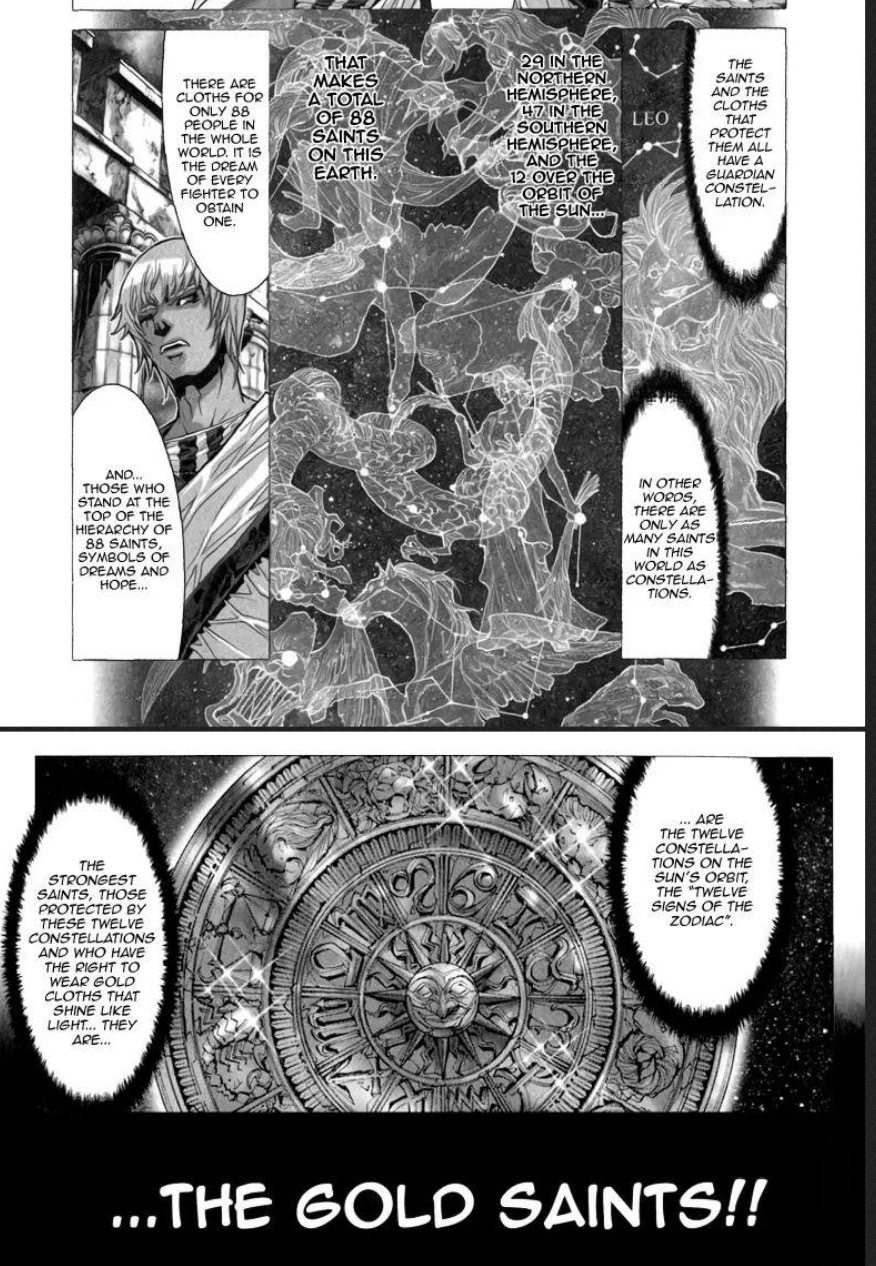
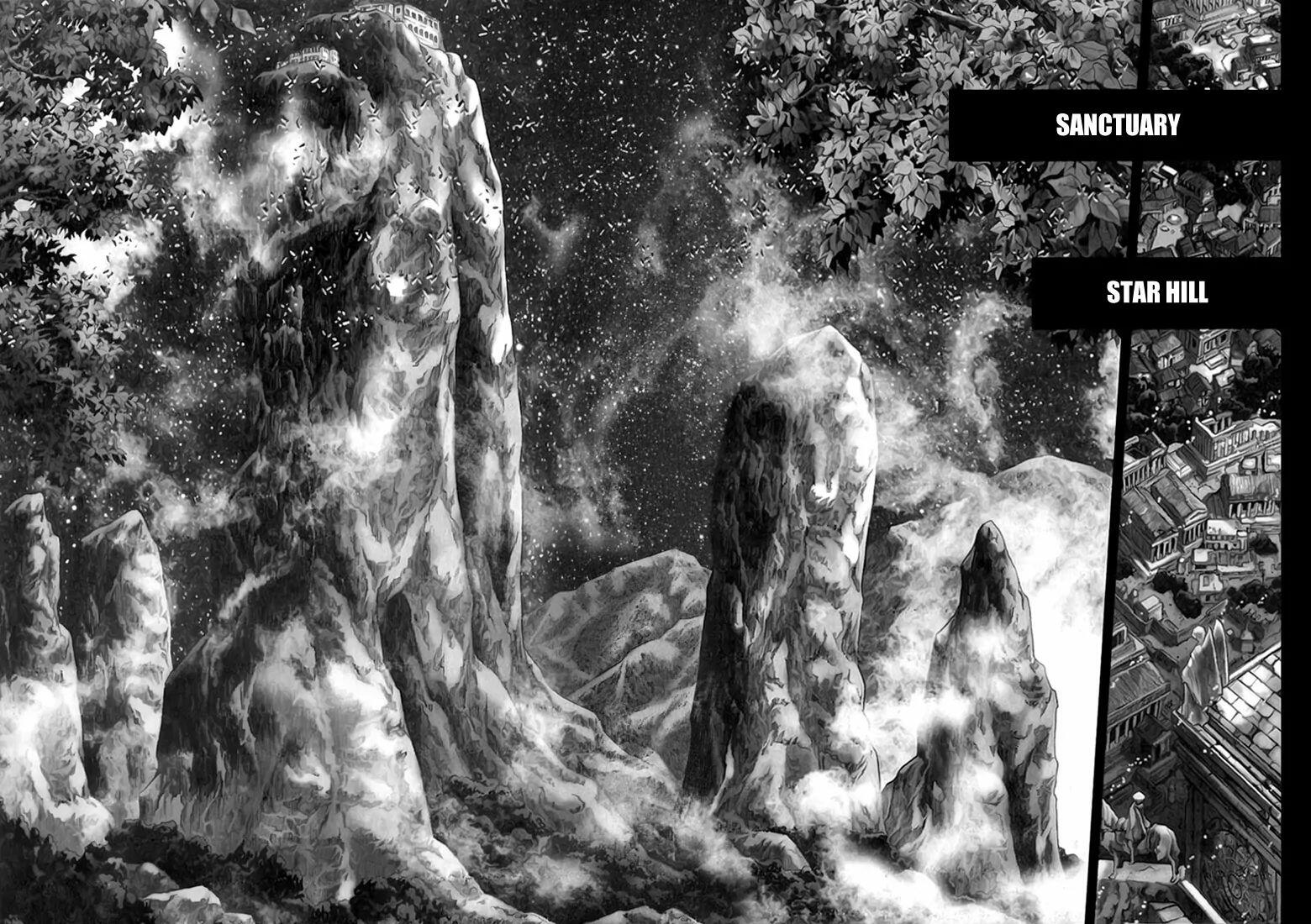
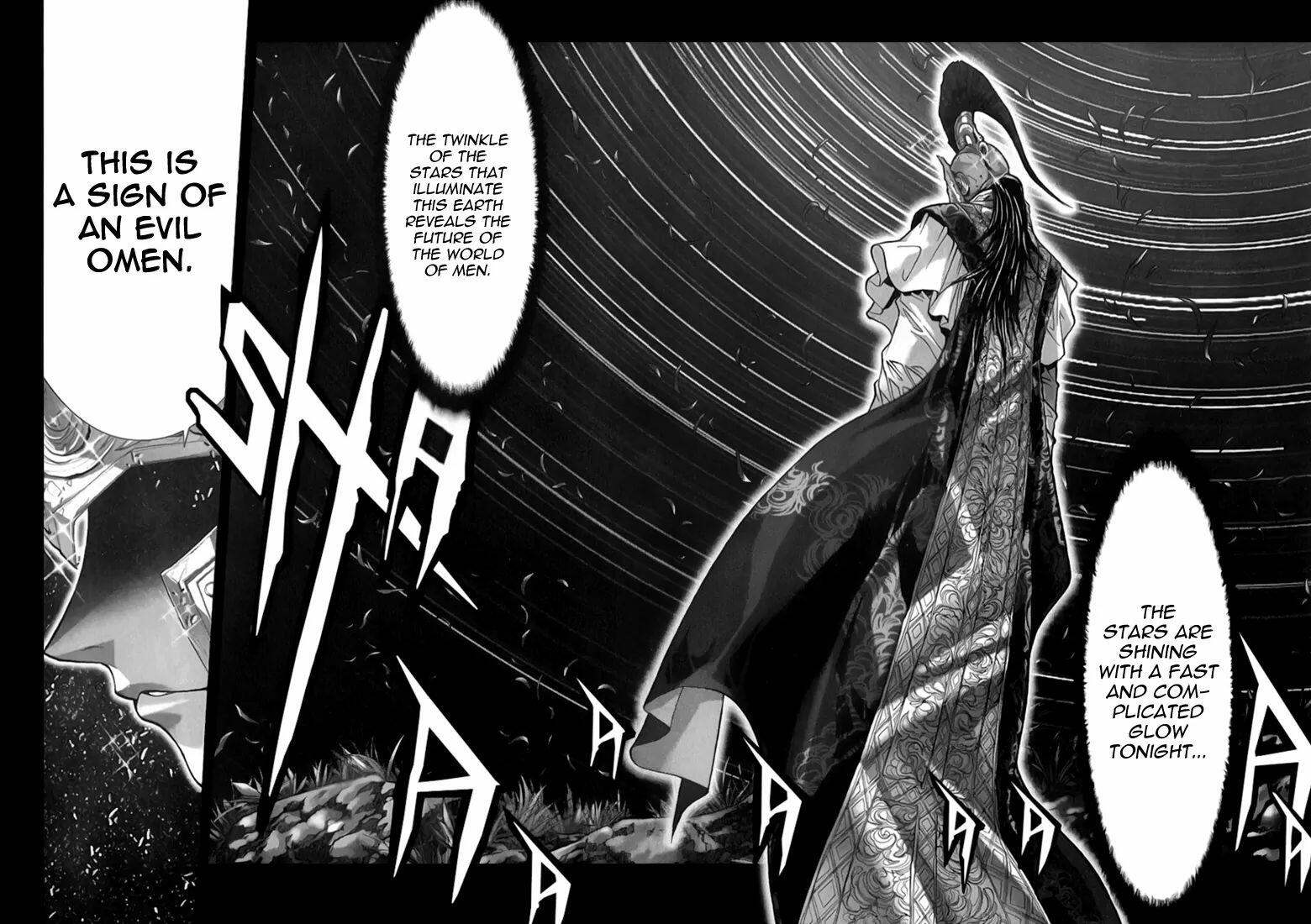
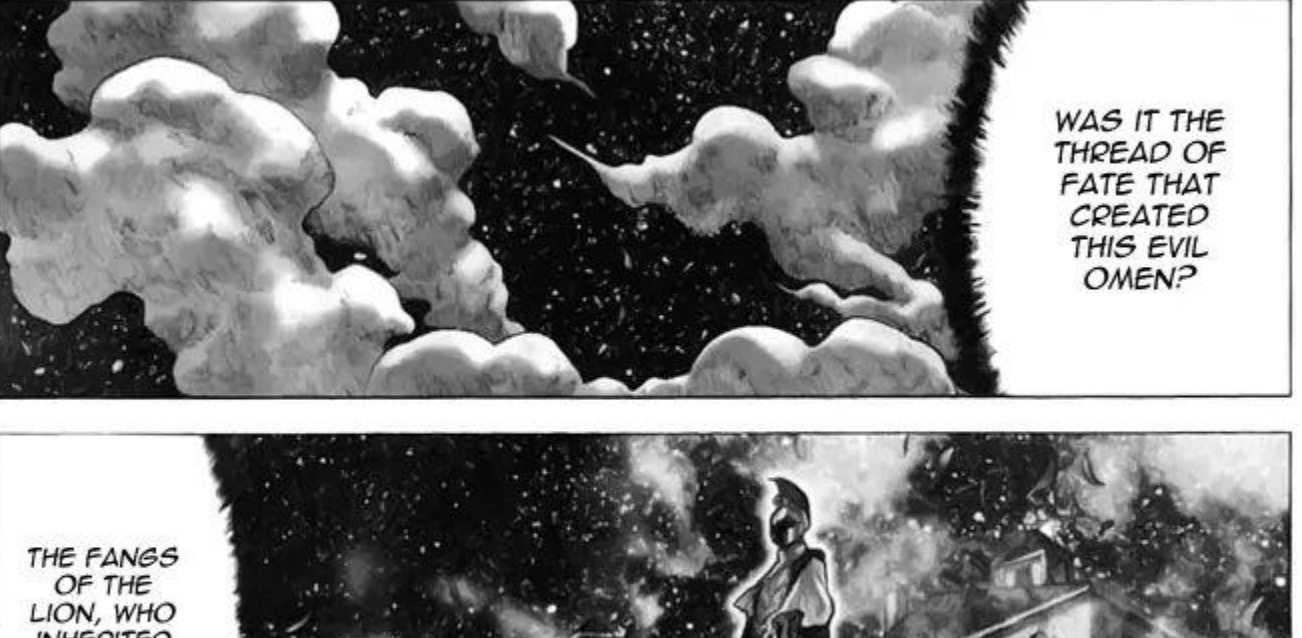





- 919
- 336
Another great find. Although I do prefer GR panels because they prove Okada didn't suddenly retcon what the constellations are for no real reason.
We know the entire night sky is black as of the latest GR chapter, implying Pontos erased alot more than just the constellations. In fact it's possible it affected the entire universe, but he also said he 'hid' the stars which I'm not too sure what that's supposed to mean, we'll have to wait and see. In any case he already scales above the revived Titans except Cronus, so Low 2-C Pontos seems like a safe bet.
We know the entire night sky is black as of the latest GR chapter, implying Pontos erased alot more than just the constellations. In fact it's possible it affected the entire universe, but he also said he 'hid' the stars which I'm not too sure what that's supposed to mean, we'll have to wait and see. In any case he already scales above the revived Titans except Cronus, so Low 2-C Pontos seems like a safe bet.
Last edited:
- 957
- 1,301
I don't remember the latest chapter giving any more shots of the night sky, although the scan in 31 shows that the Phoenix Constellation is back.
And yeah, It's definitely clear that in G/GA that the stars have never been anything but beforehand, but tbh, one thing that could actually favor @Lancelot_de_Cancer 's explanation is exactly that (the night sky thing).
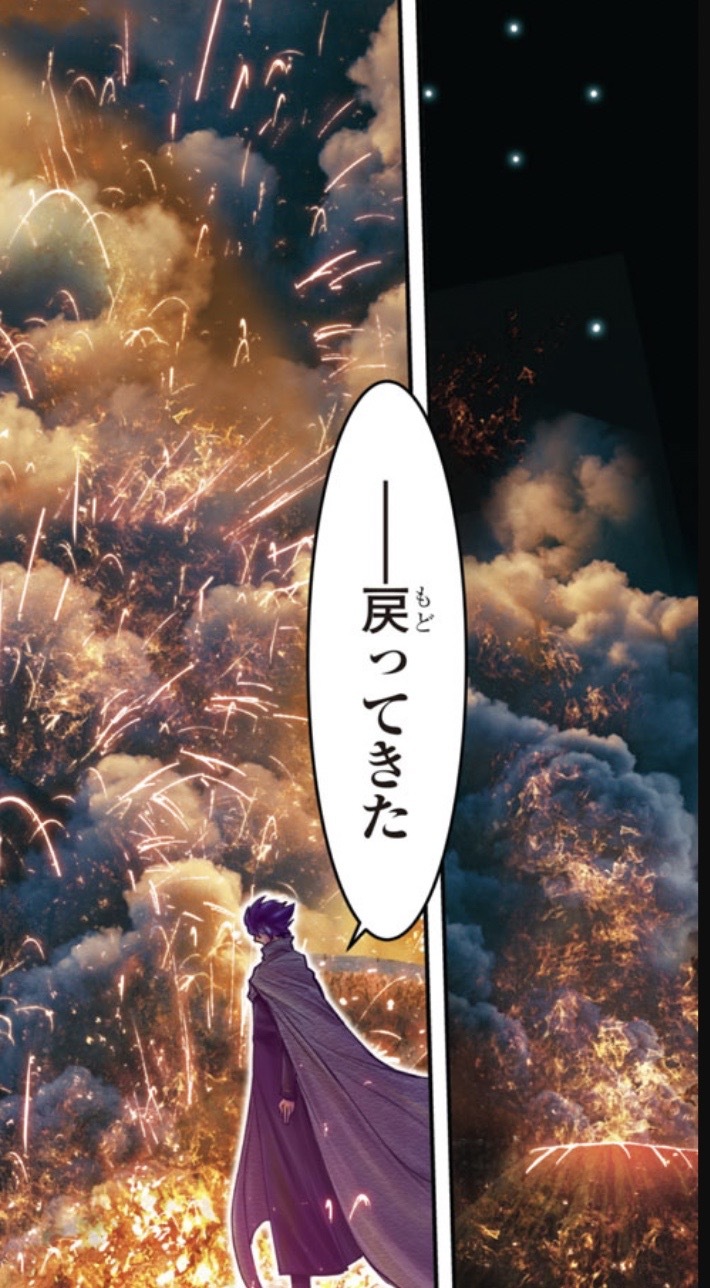
In 31, we see that in the page of Ikki's return, the Phoenix Constellation is actually already visible in Earth's sky in an immediate timeframe correlated to Ikki's revival . Basically it would be strange for this to be possible if they reappeared in their supposed positions in place light years away, especially in SS where the authors acknowledge the speed of light so often.
But at any rate I'm not really sure what to make of it since it is unarguable that before now the stars were stars, but the visuals up to now in Requiem seem to continue casting confusion on this, and I'm inclined to think @Lancelot_de_Cancer 's explanation could be more likely at the moment.
And yeah, It's definitely clear that in G/GA that the stars have never been anything but beforehand, but tbh, one thing that could actually favor @Lancelot_de_Cancer 's explanation is exactly that (the night sky thing).

In 31, we see that in the page of Ikki's return, the Phoenix Constellation is actually already visible in Earth's sky in an immediate timeframe correlated to Ikki's revival . Basically it would be strange for this to be possible if they reappeared in their supposed positions in place light years away, especially in SS where the authors acknowledge the speed of light so often.
But at any rate I'm not really sure what to make of it since it is unarguable that before now the stars were stars, but the visuals up to now in Requiem seem to continue casting confusion on this, and I'm inclined to think @Lancelot_de_Cancer 's explanation could be more likely at the moment.
- 957
- 1,301
Although then again the entire night sky seems to be devoid of stars (and this luminous meteors or whatever stuff could only apply to the constellations at most probably), so it could just be an inconsistency then perhaps? Now I'm even more confused.
Similar threads
- Replies
- 45
- Views
- 3K
- Replies
- 9
- Views
- 2K
- Replies
- 19
- Views
- 1K
- Replies
- 61
- Views
- 6K